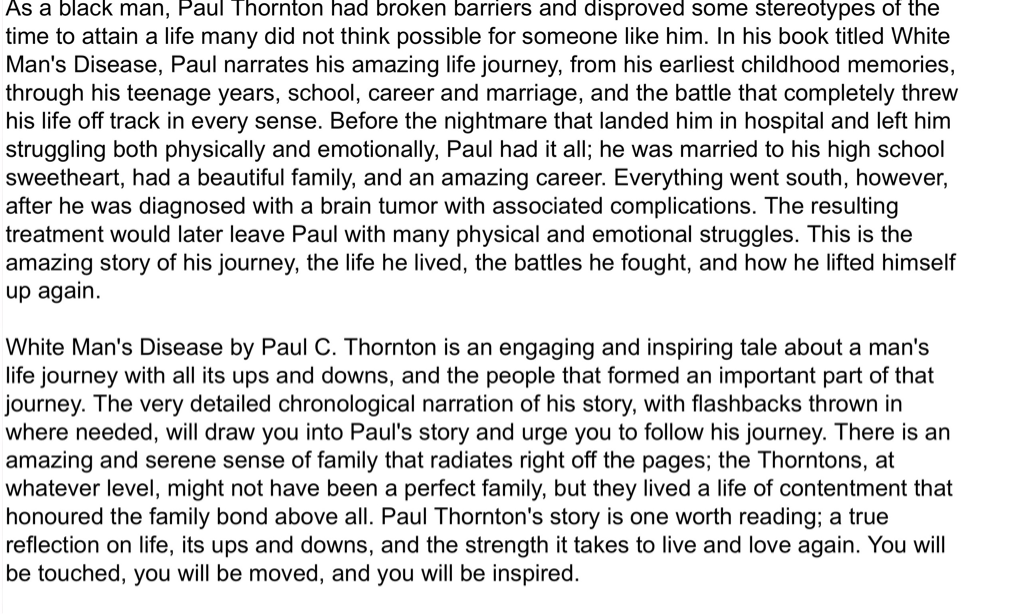Grand Prize Winner, North Street Book Prize
E-BOOK AVAILABLE ON AMAZON KINDLE, NOOK, APPLE BOOKS, KOBO OR HERE:
REVIEW-FLORIDA WEEKLY 10/26/16
REVIEW-REVIEWED BY FARIDAH NASSOZI FOR READERS FAVORITE 10/12/16
REVIEW-JAMES ABRAHAM 6/24/16
Review
White Man’s Disease
244 pp
$19.95
Book-broker Publishers of Florida
By James Abraham
“White Man’s Disease” is a book that can be judged by its cover. The image behind the butterfly cover is a brain scan, similar to the one the author received before he underwent brain surgery. And the brain scan images look a lot like cocoons, the shells in which caterpillars morph into butterflies.
Prior to the surgery, Thornton was a handsome, vibrant young man who loved music, dancing and socializing. He was married to his high school sweetheart and the father of two children. He was on the fast track at DuPont Corp., until his body betrayed him. On a routine visit to the dentist, Thornton asked about a small numb spot on his cheek. That led to a diagnosis of a vestibular schwannoma. The tumor is particularly invasive, as it is often encased is nerve tissue—ganglia essential to the normal functioning of a human being.
Thornton, who wrote part of the book from a diary he kept during the experience, describes in clinical detail the prep work and research that accompanied his ordeal. In an amusing aside, he reads about his own type of surgery in “Brain,” the medical thriller by Robin Cook, even as he describes in exacting detail the facilities and quality of care he experienced during his pre-surgery and convalescence. Then, with an honesty not common for survivors of catastrophic surgery, Thornton discusses the slough of despair that often goes unremarked upon. Behind every heroic comeback from crippling disease or injury, there’s a back story of tears and hopelessness.
In one of the book’s most poignant images, Thornton describes applying an electric nerve stimulator to his face so relentlessly his skin appeared to be scored with cigarette burns. The surgery saved his life, but cost him control of the right side of his face. His right eye had to be sutured shut. He was plagued with headaches that left him writhing on the ground. And he lost half his hearing—a crowning blow to the sometimes deejay and longtime music aficionado.
His marriage would not survive his rise out of depression, and his ex-wife would later die tragically of heart disease. But rise he did, in a manner as American as Ben Franklin’s injunctions for becoming wealthy and wise. While wallowing one day, Thornton saw an ad for a video rental business. His years at DuPont had honed his entrepreneurial spirit, so he took a chance and got in on the ground floor of the wonder business of the Eighties.
An executive at DuPont left disfigured after surgery similar to Thornton’s took the author under his wing. Thornton flourished, even as he came to grips with losing functions that were once routine. His lips could not form enough suction to smoke; he kicked the habit. He could not sip out of a cup; he used a straw. With plastic surgery and the love of a new wife, Thornton celebrated his return to the world. In the book’s final chapter, called “Coming Out,” he embraces his new reality with optimism and hearty practicality.
Paul Thornton rose from the streets of Brooklyn’s Bed-Stuy neighborhood to become a Fortune 500 executive. But that remarkable story of success pales next to the chronicle of his fight for life after a brain surgery threatened his marriage, his career, and his self-respect. Thornton’s remarkable resurrection is a story of hope, resilience, and the essential American Dream of realizing one’s full potential. Poignant, sad, tragic, funny, and compelling, “White Man's Disease” is a redemption story for the ages.
James Abraham, an award-winning literary critic, has written about books for a variety of publications including The Tallahassee Democrat, Florida Weekly, Sarasota Herald-Tribune and the Charlotte Sun. He is the editor of the Punta Gorda Literary Review
White Man’s Disease
244 pp
$19.95
Book-broker Publishers of Florida
By James Abraham
“White Man’s Disease” is a book that can be judged by its cover. The image behind the butterfly cover is a brain scan, similar to the one the author received before he underwent brain surgery. And the brain scan images look a lot like cocoons, the shells in which caterpillars morph into butterflies.
Prior to the surgery, Thornton was a handsome, vibrant young man who loved music, dancing and socializing. He was married to his high school sweetheart and the father of two children. He was on the fast track at DuPont Corp., until his body betrayed him. On a routine visit to the dentist, Thornton asked about a small numb spot on his cheek. That led to a diagnosis of a vestibular schwannoma. The tumor is particularly invasive, as it is often encased is nerve tissue—ganglia essential to the normal functioning of a human being.
Thornton, who wrote part of the book from a diary he kept during the experience, describes in clinical detail the prep work and research that accompanied his ordeal. In an amusing aside, he reads about his own type of surgery in “Brain,” the medical thriller by Robin Cook, even as he describes in exacting detail the facilities and quality of care he experienced during his pre-surgery and convalescence. Then, with an honesty not common for survivors of catastrophic surgery, Thornton discusses the slough of despair that often goes unremarked upon. Behind every heroic comeback from crippling disease or injury, there’s a back story of tears and hopelessness.
In one of the book’s most poignant images, Thornton describes applying an electric nerve stimulator to his face so relentlessly his skin appeared to be scored with cigarette burns. The surgery saved his life, but cost him control of the right side of his face. His right eye had to be sutured shut. He was plagued with headaches that left him writhing on the ground. And he lost half his hearing—a crowning blow to the sometimes deejay and longtime music aficionado.
His marriage would not survive his rise out of depression, and his ex-wife would later die tragically of heart disease. But rise he did, in a manner as American as Ben Franklin’s injunctions for becoming wealthy and wise. While wallowing one day, Thornton saw an ad for a video rental business. His years at DuPont had honed his entrepreneurial spirit, so he took a chance and got in on the ground floor of the wonder business of the Eighties.
An executive at DuPont left disfigured after surgery similar to Thornton’s took the author under his wing. Thornton flourished, even as he came to grips with losing functions that were once routine. His lips could not form enough suction to smoke; he kicked the habit. He could not sip out of a cup; he used a straw. With plastic surgery and the love of a new wife, Thornton celebrated his return to the world. In the book’s final chapter, called “Coming Out,” he embraces his new reality with optimism and hearty practicality.
Paul Thornton rose from the streets of Brooklyn’s Bed-Stuy neighborhood to become a Fortune 500 executive. But that remarkable story of success pales next to the chronicle of his fight for life after a brain surgery threatened his marriage, his career, and his self-respect. Thornton’s remarkable resurrection is a story of hope, resilience, and the essential American Dream of realizing one’s full potential. Poignant, sad, tragic, funny, and compelling, “White Man's Disease” is a redemption story for the ages.
James Abraham, an award-winning literary critic, has written about books for a variety of publications including The Tallahassee Democrat, Florida Weekly, Sarasota Herald-Tribune and the Charlotte Sun. He is the editor of the Punta Gorda Literary Review
Proudly powered by Weebly










